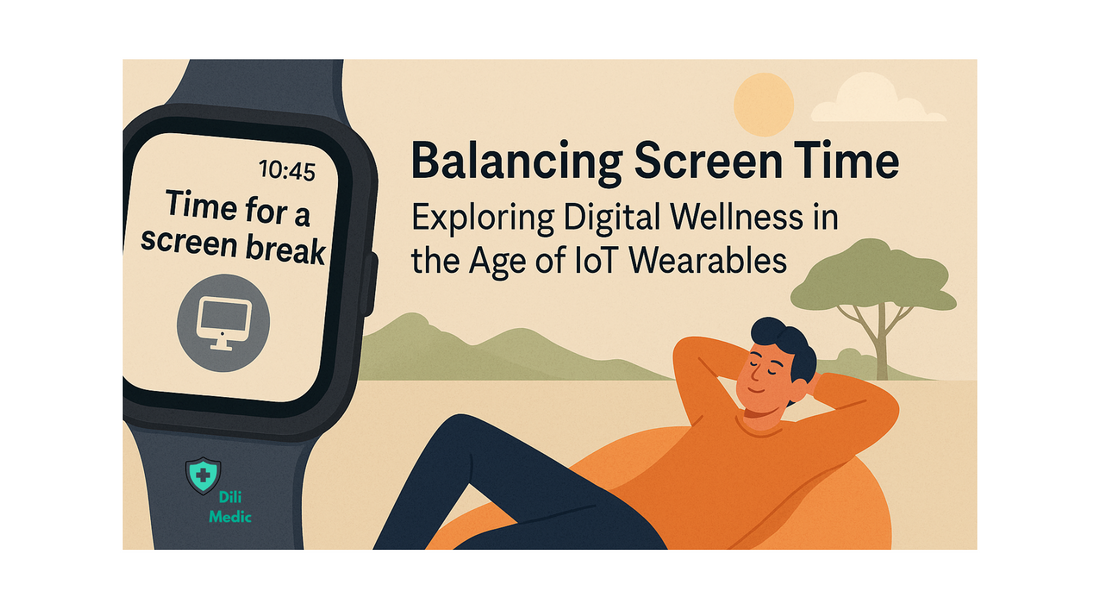
Balancing Screen Time: Exploring Digital Wellness in the Age of IoT Wearables
Share

Reclaiming Digital Balance with Smart Wearables
In today's hyperconnected world, wearables like smart rings, fitness bands, and wellness trackers are a key part of how we manage screen time and wellbeing. While these devices can empower users to make healthier digital choices, they can also introduce new challenges around over-dependency, privacy, and anxiety. This blog explores how IoT wearables can support balanced screen use without compromising mental or physical health.
Key Takeaways
| Mindful wearables combined with screen-time awareness tools help users establish healthier device habits. |
| Screen overuse can disrupt sleep, posture, and mental health through blue light and sedentary routines. |
|
Real-time tracking of stress, heart rate variability (HRV), and focus can support timely screen breaks. |
| Privacy risks and digital inequity must be addressed for effective wellness adoption. |
| Future devices will offer non-screen-based feedback and AI-guided digital balance coaching. |
The Rise of IoT Wearables in Digital Wellness

Wearable technology, including smartwatches, smart rings, and ECG-enabled patches, is evolving beyond fitness tracking to support comprehensive digital wellness. These devices are now designed to monitor key health metrics such as sleep quality and heart rate variability (HRV) with minimal user interaction. For instance, smart rings provide discreet, continuous data collection that does not rely on screen-based engagement.
A recent 2025 healthcare trends survey indicated that 85 percent of clinicians actively incorporate emerging wearable tools for continuous monitoring, early detection of health issues, and the delivery of personalized care interventions. Wearable health devices
The Screen Time Challenge

Prolonged exposure to screens has been consistently associated with a range of health concerns, including disrupted sleep patterns, digital eye strain, and adverse effects on mental well-being. Children, in particular, are at heightened risk.
According to international health guidelines, screen exposure is not recommended for infants under the age of one, while children aged two to four should be limited to a maximum of one hour per day. These recommendations emphasize the importance of establishing healthy digital habits early in life to support long-term cognitive and emotional development.
Harnessing Wearables to Promote Balance

Modern wearable devices provide proactive digital wellness companions by offering real-time, personalized feedback. These tools are capable of detecting elevated stress levels through heart rate variability (HRV) monitoring and can initiate prompts for guided breathing exercises or screen breaks. They also support ergonomic health by issuing posture reminders when prolonged inactivity is detected.
Additionally, wearables contribute to better sleep hygiene through gentle pre-bedtime notifications that encourage digital disengagement. By tracking screen-free intervals, these devices help users develop greater awareness of their digital habits and foster healthier technology engagement.
Best Practices for Healthy Screen Use

- Set measurable screen time goals. Utilize built-in device timers or wellness apps to reduce daily screen exposure by specific percentages each week.
- Create designated tech-free zones and times. Prioritize screen-free periods during meals, family interactions, and at least one hour before bedtime to support mental clarity and sleep.
- Integrate physical and digital balance. Encourage offline activities, reading books, outdoor movement, or hands-on hobbies to counterbalance screen use.
- Leverage wearable insights intentionally. Use data from smart devices to identify stress, fatigue, or overexposure, then adjust behavior accordingly for better regulation.
- Conduct regular digital wellness check-ins. Review weekly trends and metrics from wearables or screen trackers to align daily habits with long-term health goals.
Drawbacks and Ethical Challenges
- Privacy and security concerns. Wearable devices often collect highly sensitive information such as geolocation, biometric signals, heart rate, and sleep data. Ensuring this data is encrypted, stored responsibly, and used transparently is essential to maintain user trust.
- Alarm fatigue and user burnout. Frequent or poorly calibrated notifications can overwhelm users, leading to increased stress levels or complete disengagement from the device.
- Digital access and equity gaps. Many individuals may lack access to advanced wearable technology or may not fully understand how to interpret or use the data, widening the digital wellness divide.
What’s Next in Digital Wellness

Emerging innovations in digital wellness are shaping a more intuitive and seamless relationship between humans and technology. Key trends include:
- Screen-free wearable technology. Devices such as smart rings and biometric patches are increasingly designed without visual interfaces, offering subtle haptic feedback or automated prompts to encourage healthier behavior.
- Generative AI for personalized wellness plans. Advanced algorithms now synthesize biometric data, screen usage patterns, and user preferences to craft dynamic, individualized digital balance strategies.
- Smart home integration for holistic support. Wearables are beginning to sync with environmental controls, triggering changes in lighting, temperature, or soundscapes based on real-time physiological cues.
- Continued research into behavioral analytics. New developments focus on analyzing voice tone, gait, and emotional responses to detect stress levels, fatigue, or cognitive load, enhancing early intervention and adaptive care.
- Misinterpretation of health data. Without clinical guidance, users may draw inaccurate conclusions from biometric trends, potentially escalating anxiety or leading to unnecessary health concerns.
FAQs
-
Q: How much screen time is considered healthy?
Screen exposure is not recommended for children under the age of one. Children aged two to four should be limited to no more than one hour per day, according to global health guidelines. For adults, there are no universally defined limits, emphasis should be placed on screen time quality and incorporating regular breaks throughout the day. -
Q: Can wearable devices help reduce digital stress?
Yes. Wearables that monitor heart rate variability and physical inactivity can deliver timely alerts encouraging screen breaks, guided breathing, or movement, which supports emotional regulation and helps maintain a healthier work-life balance. -
Q: Are data collected by wearables secure?
Most leading wearable devices are designed with data encryption and adhere to regulations such as GDPR and HIPAA. However, it remains essential for users to stay informed about their device’s privacy policies, manage data permissions wisely, and ensure firmware is kept up to date to minimize potential risks.
